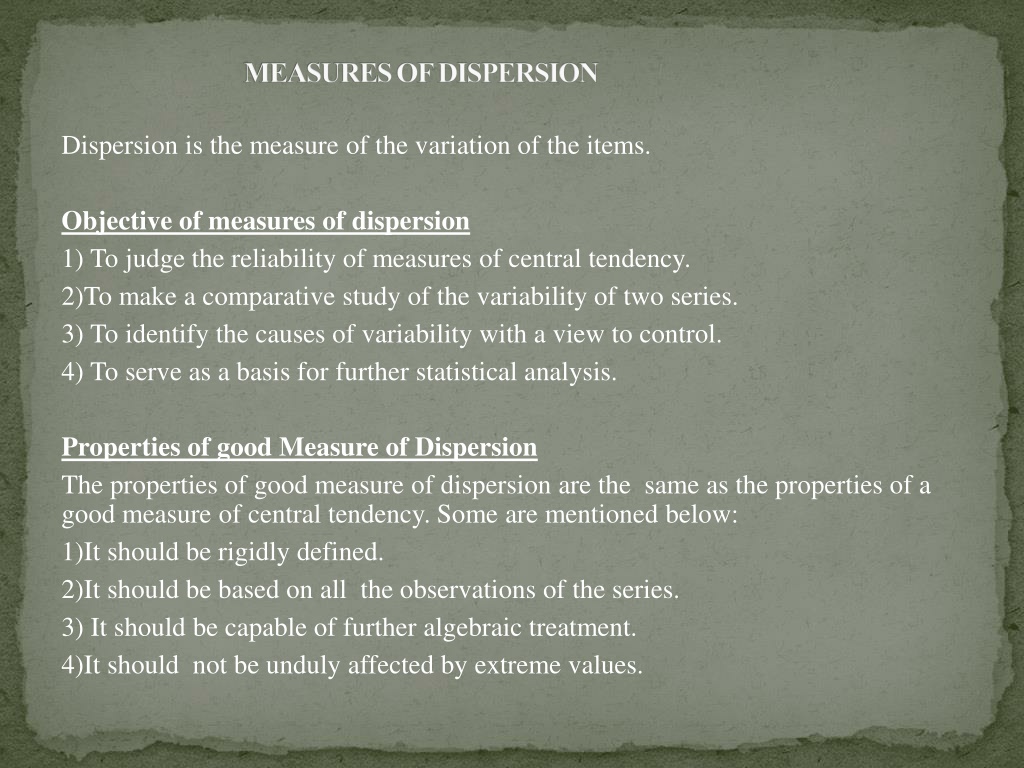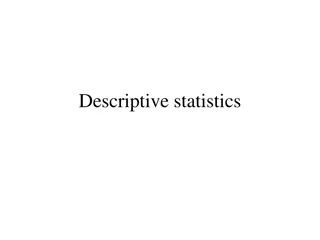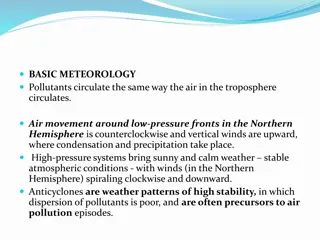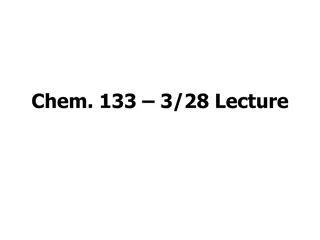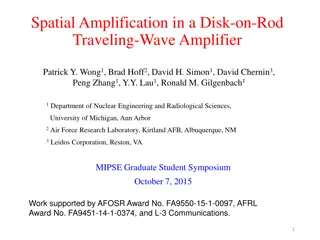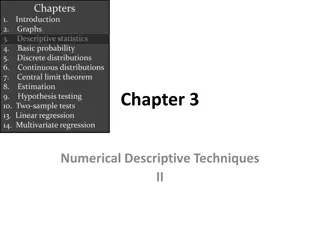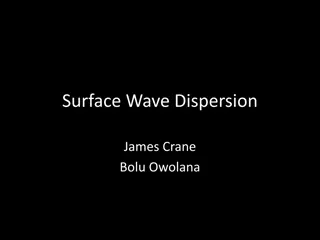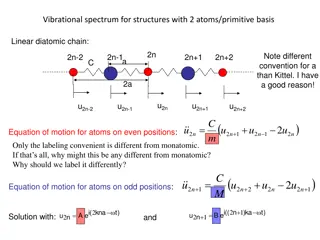Understanding Measures of Dispersion in Statistics
Measures of dispersion in statistics help in understanding the variability of data points. They are essential for assessing the reliability of central tendency measures, comparing data sets, identifying variability causes, and guiding further statistical analysis. The properties of a good measure of dispersion include being well-defined, based on all observations, algebraically treatable, and not unduly influenced by extreme values. Different measures of dispersion include absolute and relative measures like range, quartile deviation, and coefficient of variation. Range, quartile deviation, and coefficient of range are explained with examples in the context of calculating dispersion in given data sets.
Download Presentation

Please find below an Image/Link to download the presentation.
The content on the website is provided AS IS for your information and personal use only. It may not be sold, licensed, or shared on other websites without obtaining consent from the author. Download presentation by click this link. If you encounter any issues during the download, it is possible that the publisher has removed the file from their server.
E N D
Presentation Transcript
MEASURES OF DISPERSION Dispersion is the measure of the variation of the items. Objective of measures of dispersion 1) To judge the reliability of measures of central tendency. 2)To make a comparative study of the variability of two series. 3) To identify the causes of variability with a view to control. 4) To serve as a basis for further statistical analysis. Properties of good Measure of Dispersion The properties of good measure of dispersion are the same as the properties of a good measure of central tendency. Some are mentioned below: 1)It should be rigidly defined. 2)It should be based on all the observations of the series. 3) It should be capable of further algebraic treatment. 4)It should not be unduly affected by extreme values.
Different Measures of Dispersion Measures of Dispersion (or variability) a)Absolute Measures: Dispersion is expressed in terms of the original units of the series . (Example dispersion of series relating to income of a group is expressed in terms of rupees, the same unit as in original data.) Absolute measures of Dispersion are as follows: Range Inter-quartile range Quartile Deviation Mean Deviation Standard Deviation Lorenz Curve b) Relative Measure: Dispersion is measured as a percentage , or a ratio of the average. Relative measures of dispersion are as follows: Coefficient of Range Coefficient of mean deviation Coefficient of quartile deviation Coefficient of variation
RANGE It is the simplest measure of dispersion. It is the difference between largest and the smallest value in the series. Symbolically, RANGE = L-S Where L is the largest value and S is the smallest value in the series. In case of continuous series , range is calculated by subtracting the lower limit of the lowest class from upper limit of the highest class Coefficient of Range: Since range is a relative measure of dispersion, which cannot be used for comparing two distribution expressed in different unit. This difficulty is overcome by using a relative measure. If the range is divided be the sum of the extreme items the resulting figure is called coefficient of range . Symbolically, Coefficient of Range = L-S / L+S =ABSOLUTE RANGE / SUM OF THE EXTREME VALUES
EXAMPLE The profit of a company for last eight years are given below. Calculate the range and its Coefficient. Year 2010 2011 2012 2013 2014 2015 2016 2017 Profit(in 000 ) 40 30 80 100 120 90 200 230 Solution: Here L =230 and S= 30 Range = L-S = 230-30 =200 Coefficient of Range= L-S / L+S = 230-30 / 230+30 = 200/ 260 = 0.77 Merit: Simple concept East to calculate Demerits : All observations are not considered. Affected greatly by fluctuations in sampling and extreme values. Cannot be used in case of open ended distribution
Quartile Deviation Inter Quartile Range (IR): = Q3-Q1 (Difference between third Quartile and first quartile) Semi Inter-Quartile Range or Quartile Deviation(QD) = (Q3-Q1)/ 2 Quartile Deviation is an absolute measure of dispersion And as such is not useful if we need to compare two distributions with different units. Coefficient of Quartile Deviation = (Q3-Q1)/(Q3+Q1) Example: Find the Quartile Deviation And its Coefficient from the following data relating to the daily wages of seven workers. Daily Wages 50 70 80 60 65 40 90
We need to arrange the wages in ascending order as below Daily wages: 40,50,60,65,70,80,90 Q1= the value of (N+1)/4 th item or (7+1)/4 or 2nditem =50 Q3 =the value of 3(N+1)/4 th item or 3(7+1)/4 or 6thitem =80 Quartile deviation = (Q3 Q1)/2 = (80-50)/2 = 30/2 = 15 Coefficient of Quartile deviation = (Q3-Q1)/Q3+Q1 =30/130 =0.23 Discrete Series Calculate the Quartile Deviation and its Coefficient from the following data Weight(Ibs) 120 122 124 126 130 140 150 160 No. of students 1 3 5 7 10 2 1 1
SOLUTION Q1= the value of (N+1)/4 th item or (31+1)/4 th item or 8thitem =124 Ibs Q3= the value of 3 (N+1)/4 or 3(31+1)/4thitem or 24thitem= 130 Ibs Quartile Deviation = (Q3-Q1)/2 =(130-124)/2 = 6/2 =3Ibs Coefficient of Quartile Deviation = (Q3-Q1)/Q3+Q1 =6/254 = 0.0236 Continuous Series Calculate the semi inter-Quartile Deviation and Coefficient of Quartile Deviation from the following data Mark 0-10 10-20 20-30 30-40 40-50 50-60 60-70 70-80 80-90 no. of stude nts 11 18 25 28 33 30 22 15 22
Solution Q1= the value of [N/4]th item or [204/4]th item Or 51stitem which is in 20-30 group Q3= the value of 3[N/4]th item or 3[204/4]th item Or 153rditem which is in 60-70 group The value of Q1 = 28.80 The value of Q3= 63.64 Now ; sQuartile Deviation = (Q3-Q1)/2 = (63.64- 28.80)/2 = 34.84/2 = 17.42 marks Coefficient of Quartile Deviation = (Q3-Q1)/Q3+Q1 = 34.84/92.44=0.37 marks 0-10 10-20 20-30 30-40 40-50 50-60 60-70 70-80 80-90 No. of students 11 18 25 28 30 33 22 15 22 Cf 11 29 54 82 112 145 167 182 204
